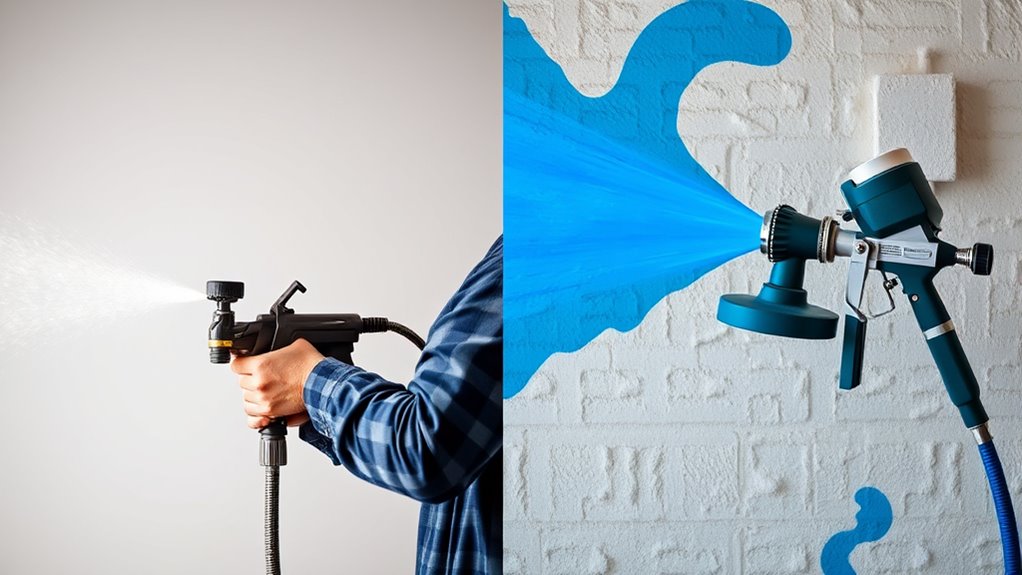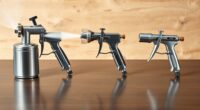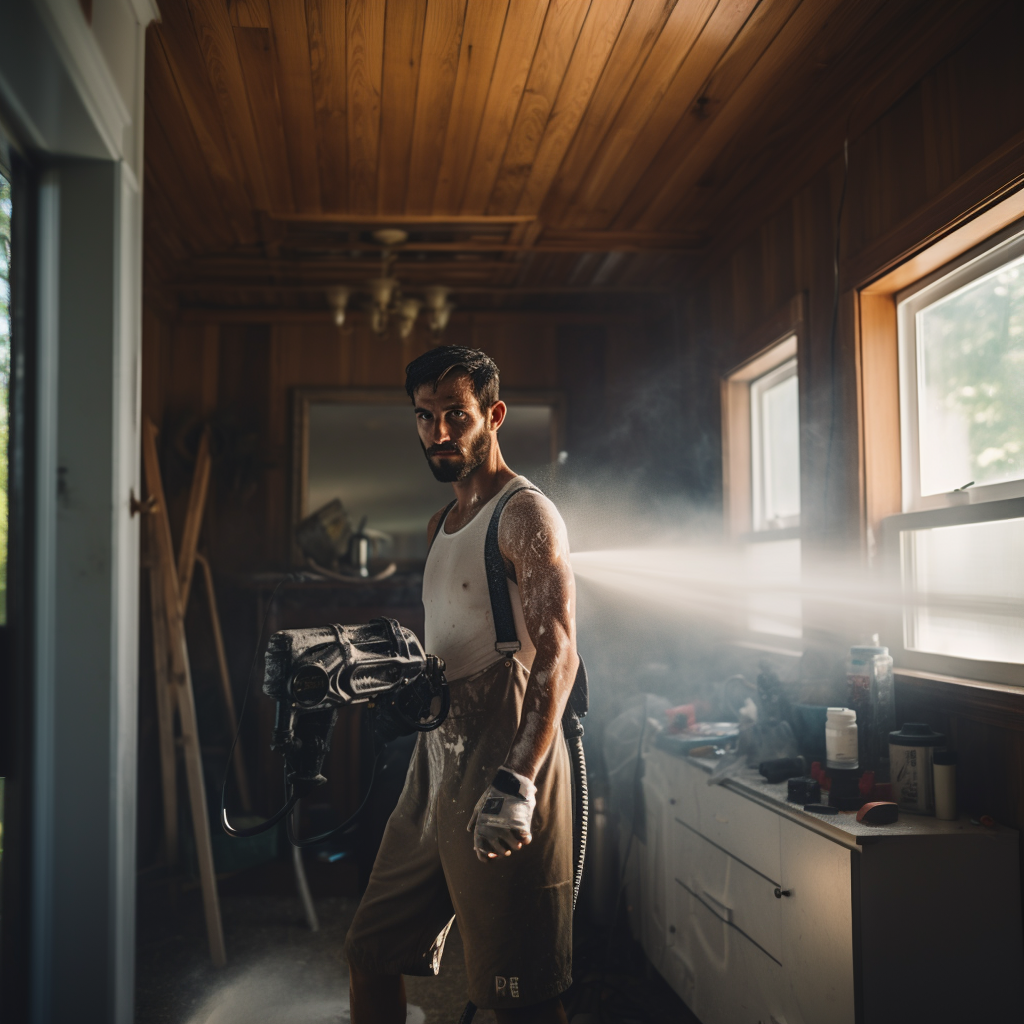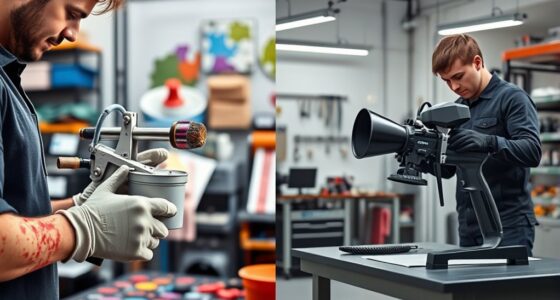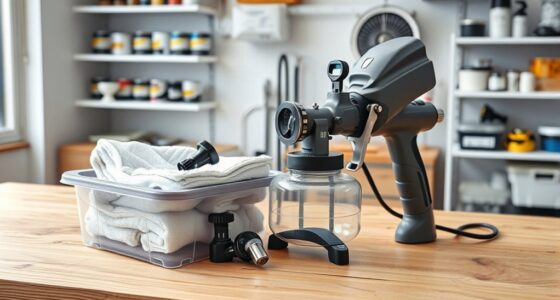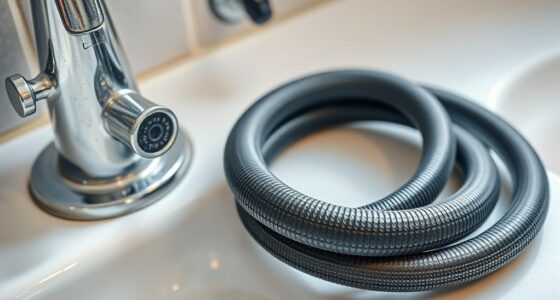Maintaining HVLP and airless sprayers involves different steps due to their unique designs. HVLP sprayers require careful cleaning of nozzles, fluid passages, and precise adjustments to spray patterns, while airless models need flushing, filter checks, and tip replacements. Both need regular upkeep, but the procedures differ to optimize performance. Want to discover specific maintenance tips and how to extend your equipment’s lifespan? Keep exploring to find out more.
Key Takeaways
- HVLP sprayers require disassembly and solvent cleaning of nozzles, while airless sprayers are mainly flushed with water or solvent.
- Regular filter and seal inspections are essential for both, but HVLP maintenance often involves more detailed nozzle care.
- HVLP generally has lower ongoing maintenance costs due to fewer wear parts, unlike airless sprayers which need frequent tip and seal replacements.
- Proper cleaning after each use prevents clogs in both systems, with HVLP needing more thorough nozzle disassembly.
- Maintenance schedules and replacement parts are typically more accessible and less expensive for HVLP compared to airless sprayers.
Overview of HVLP and Airless Sprayer Technologies
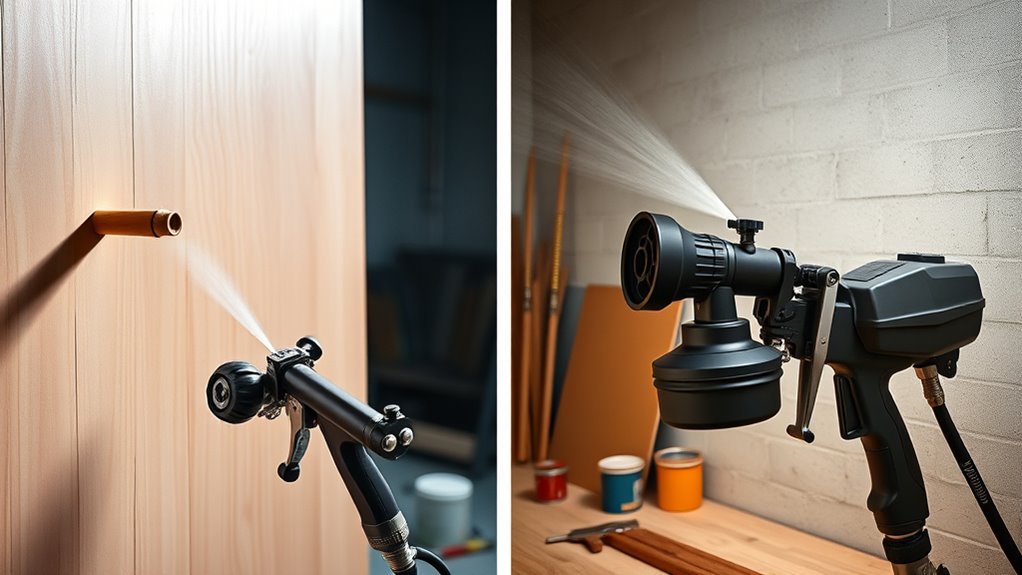
HVLP (High Volume Low Pressure) and airless sprayers are two popular types of painting equipment, each with distinct technologies that make them suitable for different projects. HVLP sprayers operate using a high volume of air at low pressure, which improves sprayer ergonomics by reducing fatigue and overspray. This setup works best with thinner paint viscosities, allowing for smooth, controlled application on detailed surfaces. In contrast, airless sprayers use a piston or diaphragm pump to force paint at high pressure through a narrow nozzle, making them ideal for large areas and thicker paints. Their ergonomics can be less comfortable during prolonged use, but they excel in handling higher viscosity paints efficiently. Understanding these differences helps you choose the right sprayer for your specific project needs. Additionally, paint viscosity plays a crucial role in determining which sprayer type will deliver the best results. Proper maintenance of sprayer equipment ensures consistent performance and longevity, regardless of the type used. Regular cleaning and inspection of nozzle and tip components are essential for maintaining optimal spray patterns and preventing clogs. Moreover, selecting the appropriate spray technique can significantly influence the quality and efficiency of your painting project.
Routine Cleaning Procedures for Each Sprayer Type
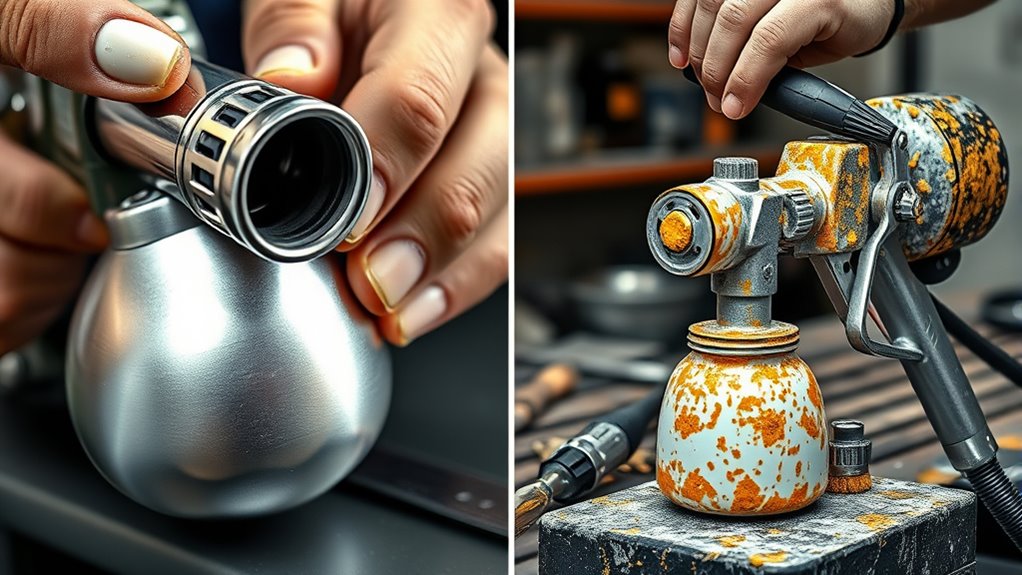
Proper cleaning is essential to keep your sprayer functioning efficiently and to extend its lifespan. After each use, start by rinsing the paint mixing cup and nozzle thoroughly to prevent clogs. For HVLP sprayers, disassemble the spray gun and clean the nozzle and fluid passages with solvent, ensuring no paint residue remains that could affect the spray pattern. Additionally, inspecting and maintaining the necessary components can help ensure your sprayer’s components stay in optimal condition. Regular maintenance of these components can also prevent build-up that may compromise spray quality. To ensure optimal performance, it’s important to follow the manufacturer’s maintenance schedules for each sprayer type. Airless sprayers require flushing with the appropriate solvent or water, depending on the paint. Pay special attention to the spray tip and filter, removing any dried paint. Maintaining a clean spray pattern depends on removing paint buildup that can cause uneven distribution. Regular cleaning not only preserves spray quality but also reduces downtime and costly repairs. Proper cleaning procedures help maintain the noise levels of your sprayer, ensuring quieter operation over time. Incorporating routine cleaning protocols can also prevent the development of clogs that impair spray consistency. Follow manufacturer instructions for specific cleaning procedures tailored to your sprayer type.
Common Wear Parts and Replacement Guidelines

Since wear and tear are inevitable with regular use, it’s important to know which parts are most vulnerable and when to replace them. Filters, for instance, need regular filter replacement to prevent clogs and maintain spray quality. Check filters frequently and replace them if they appear dirty or damaged. Seal inspection is equally critical; worn or cracked seals can cause leaks and reduce efficiency. Regularly inspect all seals and replace any that show signs of deterioration. Other common wear parts include needles, nozzles, and gaskets. Replacing these components at recommended intervals ensures consistent performance and prolongs your sprayer’s lifespan. Staying proactive with filter replacement and seal inspection keeps your equipment running smoothly and prevents costly repairs down the line. Proper maintenance of these wear parts ensures not only efficiency but also safety during operation. Additionally, understanding the different tuning options available for vehicles like Kia models can optimize performance and extend the lifespan of various components. Regularly consulting manufacturer guidelines helps identify specific replacement intervals, ensuring your sprayer remains reliable over time. Incorporating preventive maintenance practices can further enhance equipment longevity and operational safety. Being aware of potential component failures can help prevent unexpected breakdowns and costly downtime.
Storage Tips to Prevent Damage and Corrosion

Regular maintenance of your sprayer includes more than just replacing wear parts; how you store your equipment plays a vital role in preventing damage and corrosion. Proper paint storage is essential to avoid rust and clogs. Always clean your sprayer thoroughly after each use, removing residual paint and rinsing with water or solvent as needed. Make certain all parts are dry before storage to prevent moisture buildup. Store your sprayer in a cool, dry place, away from humidity and extreme temperatures. Applying a light coating of oil to metal parts can enhance corrosion prevention. Use protective covers or cases to shield the equipment from dust and moisture. Additionally, incorporating HEPA filtration into your storage area can help reduce airborne contaminants that might accelerate corrosion. Ensuring proper ventilation in your storage space further reduces humidity levels, helping to prevent rust and deterioration. Incorporating desiccants can also absorb excess moisture and further protect your equipment. Regularly inspecting your storage environment for airborne contaminants can also help maintain your sprayer’s condition. To further prevent corrosion, consider using corrosion inhibitors on vulnerable metal surfaces. Following these storage tips helps extend your sprayer’s lifespan and keeps it performing reliably.
Troubleshooting Maintenance Issues

When your sprayer starts to clog or loses pressure, troubleshooting quickly can prevent further damage and restore ideal performance. Check for blockages in the nozzle or filter, which can affect spray pattern and paint adhesion. Clean or replace clogged parts to improve spray consistency. If the spray pattern is uneven or spattering, inspect the tip and fluid passages for debris or wear. Make sure the pressure settings are correct for your project, as improper pressure can compromise paint adhesion and finish quality. Regularly clean and maintain your equipment to avoid buildup that causes clogs. Proper maintenance practices are essential for extending the lifespan of your sprayer and ensuring optimal performance. Additionally, understanding how tuning your equipment can optimize spray parameters may help in achieving better results. Maintaining correct pressure levels can also improve efficiency and prevent common issues like uneven spraying or paint waste. Troubleshooting these issues promptly helps maintain a smooth, even spray pattern and ensures your paint adheres properly, saving you time and preventing costly repairs. Incorporating regular checks of component wear can further enhance the reliability of your sprayer and reduce unexpected breakdowns.
Tips for Prolonging the Life of Your Sprayers

To keep your sprayers functioning smoothly and extend their lifespan, you should prioritize proper cleaning and maintenance after each use. Always flush out paint color thoroughly to prevent clogs and buildup that can damage the equipment. Pay attention to your user preferences, such as adjusting pressure settings or spray patterns, to avoid unnecessary wear. Regularly inspect seals, nozzles, and filters for signs of wear or damage, replacing parts as needed. Proper storage also plays a vital role—store your sprayer in a dry, clean area, protected from dust and moisture. Incorporating regular filter changes can significantly improve spray consistency and prevent clogs. Additionally, using the correct oil for airless sprayers helps maintain optimal performance and prevents internal wear. Following these tips ensures your sprayer remains reliable, reduces downtime, and preserves its performance, whether you’re using it for a small project or frequent professional jobs.
Cost Implications of Maintaining HVLP Versus Airless Models
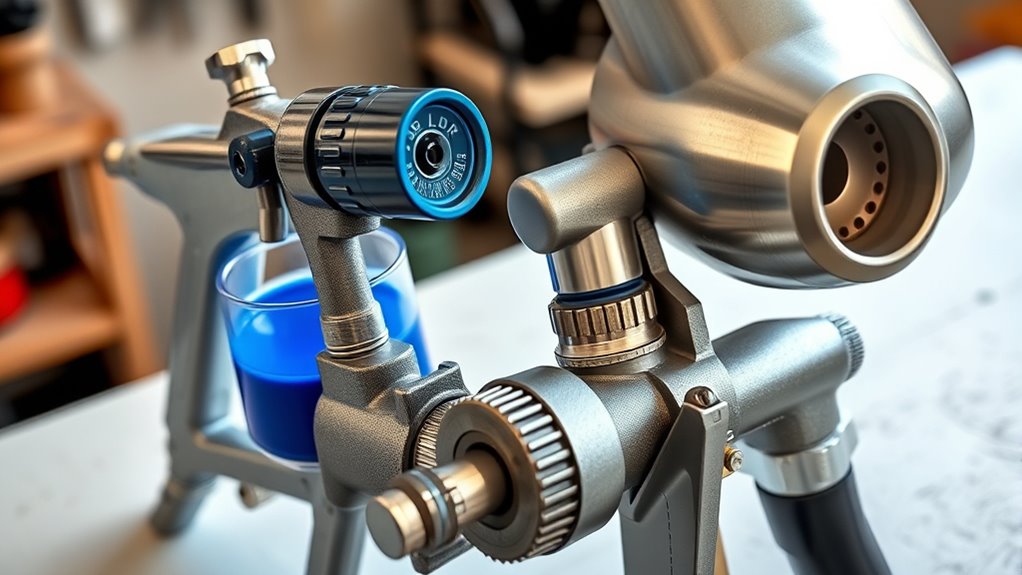
When comparing HVLP and airless sprayers, you’ll notice differences in initial purchase costs and ongoing expenses. Maintenance and repair needs also vary, impacting your overall budget. Understanding these cost factors helps you choose the model that best fits your needs and finances.
Equipment Purchase Costs
Choosing between HVLP and airless sprayers involves considering not just their performance but also the initial investment and ongoing maintenance costs. HVLP sprayers typically have a higher upfront cost due to their specialized paint nozzle and precision components, but they often require fewer repairs. Airless models usually cost less initially and are straightforward to operate, which can save you money upfront. However, they may need more frequent replacement parts, like spray tips, which can add up over time. The spray pattern quality varies between the two, influencing your choice based on project needs. While both types can fit different budgets, understanding the purchase costs helps you make an informed decision aligned with your project scope and long-term expenses.
Maintenance and Repair Expenses
Maintenance and repair costs can greatly impact the overall expenses of your sprayer, and understanding their differences helps you plan better. HVLP sprayers generally have lower maintenance costs due to fewer moving parts, but warranty coverage can vary, affecting long-term expenses. Airless models tend to require more frequent repairs, especially for wear-and-tear parts like seals and tips, which can add up over time. Spare parts availability is pivotal; HVLP parts are often easier to find and less expensive, while airless parts might be pricier and harder to source quickly. Considering warranty coverage and spare parts availability helps you gauge potential repair costs and avoid unexpected expenses, ensuring your investment remains cost-effective over its lifespan.
Frequently Asked Questions
How Often Should I Schedule Professional Maintenance for My Sprayer?
You should schedule professional maintenance for your sprayer at least once a year, or more often if you use it frequently. During this maintenance, they’ll perform sprayer calibration to guarantee accurate paint flow and replace filters to prevent clogs. Regular upkeep keeps your sprayer working smoothly, improves finish quality, and extends its lifespan. Don’t wait until issues arise—routine maintenance is key to peak performance.
Are There Eco-Friendly Cleaning Products Suitable for HVLP and Airless Sprayers?
Think of your sprayer as a delicate garden that needs gentle care. You can find eco-friendly solvents and biodegradable cleaners designed for HVLP and airless sprayers, which clean effectively without harming the environment. These products break down naturally and reduce chemical waste, making your maintenance routine more sustainable. Using eco-friendly options helps protect your tools and the planet, ensuring your sprayer stays in top shape while caring for nature.
Can Improper Storage Cause Long-Term Damage to Sprayer Components?
Improper storage can definitely cause long-term damage to your sprayer components. Storage issues like exposure to moisture or extreme temperatures lead to component corrosion, which weakens parts over time. If you neglect proper storage, you risk costly repairs and reduced sprayer lifespan. To avoid this, clean your sprayer thoroughly, store it in a dry, climate-controlled space, and guarantee all parts are protected from moisture and corrosion.
What Are Signs Indicating the Need for Early Replacement Parts?
Like a car showing warning lights, your sprayer signals when parts need replacing. Watch for signs like nozzle wear, which causes uneven spray, and gasket deterioration, leading to leaks. If you notice decreased spray quality, increased pressure, or leaks, it’s time for early replacement parts. Staying attentive to these signs guarantees your sprayer runs smoothly, preventing costly repairs and extending its lifespan.
How Do Maintenance Routines Differ for High-Volume Versus Low-Volume Spraying?
You should tailor your maintenance routines based on your spray volume. For high-volume sprayers, focus on regular sprayer calibration to ensure consistent coverage, and keep nozzle maintenance up-to-date to prevent clogging. Low-volume sprayers require less frequent calibration but still need routine nozzle cleaning to maintain spray quality. Both types benefit from consistent inspections and cleaning, but the emphasis on calibration and nozzle upkeep varies depending on your spray volume.
Conclusion
Think of your sprayer as a trusted tool in your creative arsenal. By understanding the differences and following proper maintenance, you’ll keep it running smoothly—like a well-oiled machine that never misses a beat. Whether you’re wielding HVLP or airless, proper care is your secret weapon against wear and tear. With each cleaning and upgrade, you’re not just maintaining a sprayer; you’re safeguarding your artistry, ensuring your projects shine bright like a beacon of craftsmanship.
Franz came aboard the Paint Sprayer Zone team with a background in both journalism and home renovation. His articulate writing style, combined with a passion for DIY projects, makes him an invaluable asset. Franz has a knack for breaking down technical jargon into easy-to-understand content, ensuring that even the most novice of readers can grasp the complexities of paint sprayers.
